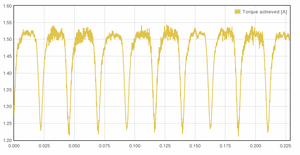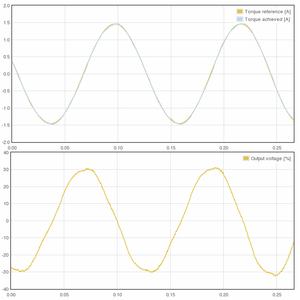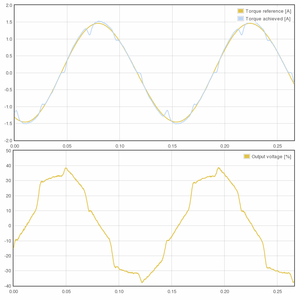Difference between revisions of "Dead-time distortion"
| [checked revision] | [checked revision] |
| Line 25: | Line 25: | ||
==Measurements== | ==Measurements== | ||
| − | ===Dead time distortion | + | ===Dead time distortion=== |
[[File:Currentripple w deadtime distortion.png|300px|thumb|Distortion correction disabled. Top graph: phase current reference and achieved current. Bottom graph: PWM duty cycle reference]] | [[File:Currentripple w deadtime distortion.png|300px|thumb|Distortion correction disabled. Top graph: phase current reference and achieved current. Bottom graph: PWM duty cycle reference]] | ||
These graphs show actual distortion on sinusoidal motor currents when [[PWM]] frequency was 17.5 kHz and dead-time length 2 µs. No countermeasures were taken to reduce distortion. | These graphs show actual distortion on sinusoidal motor currents when [[PWM]] frequency was 17.5 kHz and dead-time length 2 µs. No countermeasures were taken to reduce distortion. | ||
| Line 33: | Line 33: | ||
Also notice how PWM duty cycle reference from drive [[Torque controller|torque/current controller]] jumps up/down trying to compensate dead time errors. However, no current controller alone is fast enough to completely eliminate current ripples. | Also notice how PWM duty cycle reference from drive [[Torque controller|torque/current controller]] jumps up/down trying to compensate dead time errors. However, no current controller alone is fast enough to completely eliminate current ripples. | ||
| − | ===Dead time | + | ===Dead time elimination=== |
[[File:Currentripple w deadtime correction2.png|300px|thumb|[[VSD-XR]] distortion correction enabled. Top graph: phase current reference and achieved current. Bottom graph: PWM duty cycle reference]] | [[File:Currentripple w deadtime correction2.png|300px|thumb|[[VSD-XR]] distortion correction enabled. Top graph: phase current reference and achieved current. Bottom graph: PWM duty cycle reference]] | ||
This is the exactly same experiment with the one above but this time [[VSD-XR]] dead time correction was turned on. Notice how dips almost completely disappear and PWM duty cycle reference shows more sine-like waveform. | This is the exactly same experiment with the one above but this time [[VSD-XR]] dead time correction was turned on. Notice how dips almost completely disappear and PWM duty cycle reference shows more sine-like waveform. | ||
[[Category:Technology]] | [[Category:Technology]] | ||
[[Category:Drive features]] | [[Category:Drive features]] | ||
Revision as of 23:31, 12 April 2012
Dead time distortion (DTD) is a problem found in all PWM based drives. The longer dead time used, the more problematic distortion becomes.
Contents
Phenomenon
Dead time distortion is present in some extent in all half-bridge topology PWM power outputs.
Description of the image:
- Schematic: typical single phase half-bridge PWM power output consisting two transistors and an inductive load (inductor). In 3 phase motor drives there are 3 pcs of this kind of circuits excluding inductor (which is replaced by a motor coil).
- Desired load voltage waveform: the distortion free waveform reference signal on load that we would want to see.
- PWM to top transistor: PWM signal that is controls when the top side transistor is in conductive state.
- PWM to bottom transistor: PWM signal that is controls when the bottom side transistor is in conductive state.
- Grey areas: time when neither of PWM signals are in "on" state making both transistor non-conductive. This is necessary to prevent on-state overlapping and shoot-through currents from V+ to GND.
- Positive current load voltage: this is the achieved (distorted) PWM signal on load when current direction is positive in load inductor.
- Negative current load voltage: this is the achieved (distorted) PWM signal on load when current direction is negative in load inductor.
As it figure shows, actual output voltage differs from desired load voltage. Actual PWM duty cycle either becomes higher or lower than desired and distortion direction changes whenever current direction reverses.
Distortion effects

Some of most notable motion control problems caused by DTD:
- Unwanted ripple in torque that may reduce motion smoothness
- Causes "electrical backlash" or laziness on motor control. With DTD, motor reaction time is increased whenever current direction is reversed (such as motor is reversing direction). This increases tracking error of servo motor.
- More difficulty in servo tuning
- Reduced servo stiffness
Measurements
Dead time distortion
These graphs show actual distortion on sinusoidal motor currents when PWM frequency was 17.5 kHz and dead-time length 2 µs. No countermeasures were taken to reduce distortion.
Notice the current dips in otherwise sinusoidal signal. There are 6 dips per sine cycle because in this experiment the test was done on a 3 phase motor which has 3 sine currents with 60 degree phase angle differences. Only one phase is displayed but distortion of two remaining phases will induce dips also in the neighbor phases.
Also notice how PWM duty cycle reference from drive torque/current controller jumps up/down trying to compensate dead time errors. However, no current controller alone is fast enough to completely eliminate current ripples.
Dead time elimination

This is the exactly same experiment with the one above but this time VSD-XR dead time correction was turned on. Notice how dips almost completely disappear and PWM duty cycle reference shows more sine-like waveform.

